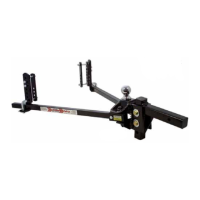7
A product of
Check all hardware before each trip. Do not tow your trailer until all
bolts and nuts have been checked for wear and fatigue, are properly
tightened, and all pins and clips are securely in place.
Do not tow your trailer on rough roads. Do not tow your trailer through
profound ditches, dips, or swales. Excessive strain on the spring arms
and hitch head may cause hitch fatigue or failure.
If your dealer installed your hitch, make sure to verify that it is still ad-
justed correctly after loading your trailer and tow vehicle for your trip.
Replace worn, faded, or unreadable warning stickers on the spring
arms and arm sockets.
Do not transfer hitch to a different tow vehicle or trailer without
re-adjusting the hitch.
Important Hitch Information
Weight Distribution:
Weight distribution is the ability of a hitch to transfer some of the tongue
weight of the trailer ahead to the tow vehicle axles, and backward to the
trailer axles. Without weight distribution the tow vehicle “teeter-totters” on
the rear axle of the tow vehicle, and unweights the front axle. Proper weight
distribution transfers weight back to the front steering axle, forcing it back
to the ground.
Proper weight distribution also adds performance to the integrated sway
control feature of your Equal-i-zer
®
hitch. The Equal-i-zer hitch requires a
minimum tongue weight of at least 10% of gross trailer weight. This tongue
Do not loosen or remove any part of the hitch except the L-pins and L-
pin clips while the hitch is under load.
Always secure tow vehicle and trailer with parking brake and wheel
chocks before setting up or adjusting hitch.

